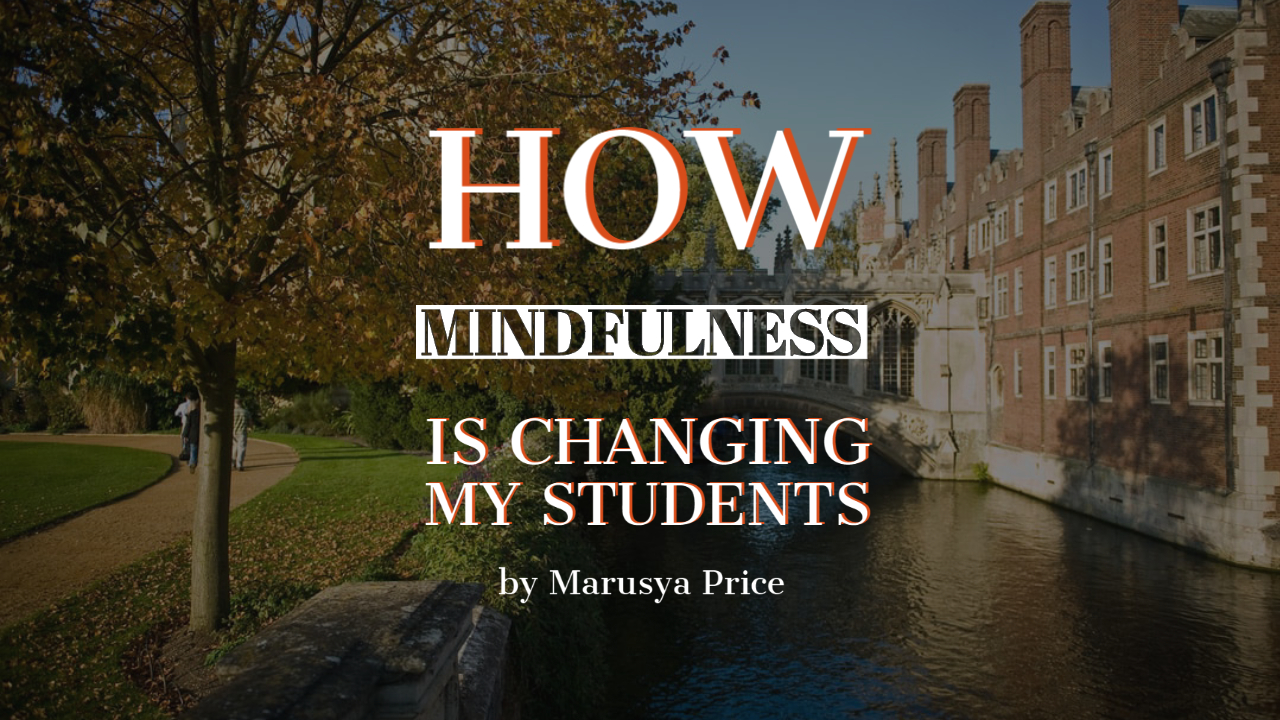Empowering my students is my lifelong quest. There is nothing more fulfilling than seeing how they grow not only as confident English speakers but also as compassionate, kind and self-assured individuals. Once a pupil told me:
“A teacher is like a flashlight. They illuminate our way forward.”
And how accurate she was! We, teachers, need to make sure that we have the correct “water” to help our “flowers” grow, don´t we?
Inspirational stories, songs, videos, or pictures have always been the main “ingredient” in my perfect teaching recipe. However, for the last two years I have been boldly utilising mindfulness tools in my English lessons. What prompted me was witnessing the anxiety and emotional turmoil my students were going through. They were struggling to cope with teacher and parent pressure, upcoming exams and low self-esteem. In addition, parents were concerned that their children could not focus well and this affected their academic performance.
So after seeing the powerful effect that mindfulness has had on my personal life, I decided to apply its principles in my teaching practice. Not only did I introduce meditation to my students gradually but also started creating my own visualisations and building lesson plans around them. Surprisingly, it didn´t take me long to reap the benefits of my new mindful techniques: I noticed how my students were becoming less reactive, more aware of what was going inside and around them and started to appreciate things that they would normally take for granted.
Here are some of my students´ pieces of writing which illustrate their personal transformation:
#1 Seeking calm
Introducing meditation to my students came after witnessing the calming influence it has had on me. Seeing them constantly stressed out, reactive and anxious prompted me to embrace this mindfulness technique and make it a regular activity in my English lessons. Here is an extract from a student´s text about creating sweet memories.
“When I drink peach cola, the bad things in my heart go away with the bubbles. When I taste the peach, it brings sweet memories…”
Christina, 14, China
#2 Being aware of the power of mindful breathing
Godlie Hawn, the founder of MindUp says “A happy brain is a happy that can learn” and I could not agree more. My students and I often talk about the role of the amygdala and how mindful breathing can help it relax and tell the nervous system: “I am OK!” This is an excerpt from a teenager´s essay on challenges that young people face nowadays.
“Before an exam, I feel how my soul is sucked out of my body. Then I use mindful breathing to calm myself down. “
Harry, 15, China
#3 Believing in yourself
Oftentimes I hear students say: “I don´t believe in myself.” Or “I am not good enough”. It breaks my heart to see so many students whose wings have been clipped by parents´ ambitions, teachers´ expectations or society. So when I heard DJ Khaled and Demi Lovato´s song “I Believe”, I knew I had to create a lesson around it. One of the activities involves writing a poem with the same title and I was really pleased with the beautiful poetry the students came up with. Here´s a poem written by a young Chinese girl.
I believe
Whenever I see a snail crawling slowly
Whenever I hear the cicada rattling loudly
When I know even a little ant can lift a leaf
I tell myself
To try everything cause
I have the most incredible power.
If there is still chance, still light
Whatever difficulty I am faced with
I’ll still spare no effort
to catch my dream
to lighten up my life
Sarah Wang, 16, Wenzhou, China
#4 Promoting the sense of connectedness and unity
I believe that one of the best ways to fight against racism and inequality is by using mindfulness. This is a powerful way to spread compassion and loving kindness in the world. This is an extract from a student´s article inspired by my lesson about anti-racism.
The world, consisting of different people with different skins, homes, customs as well as hobbies, is the place that we live. It is these differences that make the Earth a lively and colourful whole world. However, prejudice to others contributes to a large number of conflicts and violence.
But all of these are not what we want. All we want is just a peaceful and harmonious world. Only when we eradicate the root of racism can we truly turn the prejudice into compassion. We have planted many seeds of peace into our next generation, hoping they will leave the wars behind. I am waiting for the time when the barriers between us go tumbling down when the world truly becomes a unity.
Jessica, 16, China
#5 Celebrating your uniqueness
I often use mediation before a writing activity in order to help my students unleash their creativity. I tend to give them a prompt and allow them to pen their ideas. Here´s a writing prompt that I used a while ago with young learners.
Write a dialogue between a book character and an object they are associated with, for instance, Harry Potter and his magic wand.
This prompt came about after one of my students claimed she could not imagine that her favourite book character would sit next to her. So when she said “I usually talk to objects around me.”, I provoked her to write a dialogue between a book character and an object he/she is associated with. We had just finished reading the book “Pollyanna grows up” so I suggested writing a conversation between Jamie, who is physically challenged and his crutches. She gladly agreed and oh, boy, I am so happy I listened to my student because her story is full of compassion, love and light. This is what she wrote:
Jamie was sitting by his bed, thinking of his lame legs. He had a feeling that his legs were rubbish. They couldn’t stand by themselves. They couldn’t jump or run. He felt really sad. Suddenly he heard a voice.
“Jamie,” the voice said.
Jamie looked up, turned his head around, “Who’s there?”
“It’s me, Jamie, your crutches.” said the voice.
Jamie looked at his crutches at once. It didn’t seem to change much.
“Let’s talk, Jamie, my old friend,” hissed the voice, “Yes, let’s talk. How do you feel about your lame legs?”
“Er – uncomfortable,” said Jamie, “yeah, extremely uncomfortable. I can’t run or jump like the others. That took a lot of fun out of my life.”
“Sure, you can feel bad about that.” that voice seemed to lighten up a little, “That’s the outside. What about the inside? Have you ever taken a look deep inside yourself? That’s who you’re meant to be. You are Jamie. You are positive and smart. So don’t feel shame about your legs. They make you more unique. They make you the only Jamie in the world. So take great care of yourself and see who you are inside.”
Then the voice disappeared. Just like it has never been there before. Is this just a dream? Jamie thought. But then, he truly felt he was unique and powerful.
Sissy Ma, 13, China
#6 Involving the senses to stay present
One of the ways I am teaching my students to live in the moment is by waking up their senses every time an opportunity arises. My favourite method is by using visualisations. For the last two years, I have been creating my own guided imagery and my students´ positive reaction has been truly inspiring. I often encourage them to write their own sensory “virtual journeys”. Here is an extract from a student´s imaginary underwater adventure:
Imagine yourself diving in the sea. You hear nothing but your own breath… A large school of fish is moving above you, shining silver light like a big mirror. You don´t know where they are heading but you wish them a nice trip… Suddenly you are surrounded by many fish in different colours, sizes and shapes. Some are green and look like a triangle; others are red and look like an arrow…You touch a seashell and notice how smooth it is…
Bea, 25, Spain
Finally, this is a tiny portion of my students´ transformational stories. They always tear me up and leave me hopeful that the next generation will make the world a peaceful and better place.


